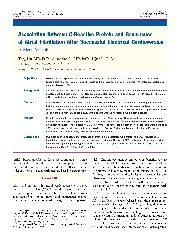摘要
Objectives We conducted a systematic review and meta-analysis of observational studies to examine the association between baseline C-reactive protein (CRP) levels and the recurrence of atrial fibrillation (AF) after successful electrical cardioversion (EC).
Background Current evidence links AF to the inflammatory state. Inflammatory indexes such as CRP have been related to the development and persistence of AF. However, inconsistent results have been published with regard to the role of CRP in predicting sinus rhythm maintenance after successful EC.
Methods Using PubMed, the Cochrane clinical trials database, and EMBASE, we searched for literature published June 2006 or earlier. In addition, a manual search was performed using all review articles on this topic, reference lists of papers, and abstracts from conference reports.. Of the 225 initially identified studies, 7 prospective observational studies with 420 patients (229 with and 191 without AF relapse) were finally analyzed.
Results Overall, baseline CRP levels were greater in patients with AF recurrence. The standardized mean difference in the CRP levels between the patients with, and those without AF was 0.35 units (95% confidence interval 0.01 to 0.69); test for overall effect z-score = 2.00 (p = 0.05). The heterogeneity test showed that there were significant differences between individual studies (p = 0.02; i(2) = 60.2%). Further analysis revealed that differences between the CRP assays possibly account for this heterogeneity.
Conclusions Our meta-analysis suggests that increased CRP levels, are associated with greater risk of AF recurrence, although there was significant heterogeneity across the studies. The use of CRP levels in predicting sinus rhythm maintenance appears promising but requires further study.
- 出版日期2007-4-17
- 单位天津医科大学
